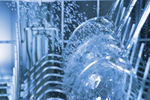Hot water represents about 16% of a home’s energy bill. It is possible to use less hot water by barely changing your habits and by opting for more efficient products.
Hot water
A few numbers... to think about!
| Water consumption | Activity |
|---|---|
| 25 litres of water | 5 minutes of washing dishes under the tap |
| 10 to 20 litres of water | One washing cycle with a dishwasher |
| 75 to 150 litres of water | One bath |
| 35 litres of water | One 6-minute shower with a low-flow showerhead |
| 70 to 90 litres of water | One washing in a front-loading washer |
| 150 litres of water | One washing in a top-loading washer |
| 800 litres of water, or the equivalent of four bathtubs of water | One drop leaking from a faucet every second for one month |
Repair leaky faucets
One drop of hot water leaking every second from a faucet over a period of one month means 800 litres of hot water that go to waste. It is the equivalent of 4 bathtubs of water!
Repair your leaky faucets then take the time to install aerators which will reduce your faucets’ flow rate.
Use low-flow faucets
There are many high performance products on the market today, such as products with WaterSense® certification. They ensure a maximum water flow of 5.7 litres per minute while being just as effective as standard faucets. They will reduce your water consumption by 40% compared to traditional products and will not sacrifice your comfort. This translates into tens of thousands of litres of water saved every year!
Use a front-load washer
Front-loading washing machines use 70 to 90 litres of water per load. A top-loading washer needs twice that amount, which means about 150 litres per load.
If you need to change your washing machine, select a front-loading model with the ENERGY STAR® logo.
Also, make it a habit to wash and rinse your clothes in cold water: selecting the cold water cycle on a front-load washer can save about 50 litres of hot water.
Take a shower instead of a bath
Taking a bath means using between 75 and 150 litres of water. A 6-minute shower with a low-flow showerhead only uses 35 litres of water.
Some showerheads use up to 14 litres of water per minute while others limit their consumption to 9.5 litres or even 5.7 litres per minute. They can easily cut your water consumption in half.
Clean your dishes without wasting water
Cleaning your dishes for five minutes under the tap uses 25 litres of water while a cleaning cycle from a dishwasher needs around 13 litres of water.

If you hand-wash your dishes, do not let the water run continuously. Use a small plastic tub or the sink filled with water.
If you are using a dishwasher, fill it up to capacity every time and try not to rinse your dishes too much before placing them in the machine! An ENERGY STAR dishwasher can also help you reduce your hot water consumption.
Drain water heat recovery system
Recover heat from the water you just used
To reduce your energy consumption, you can install a drain water heat recovery system. This device allows you to use the heat from the discharged water, for example when you take a shower, to preheat the water that supplies the water heater.
In winter, when the water temperature in the water supply is 5 °C, the heat recovery system can preheat the water before it enters the water heater. Depending on the recovery system selected, the preheated water can reach a temperature of approximately 17 °C.
Heat recovery is optimal when you use and simultaneously release large amounts of hot water, which is the case when you take a shower. Thus, to maximize its effectiveness, the device will have to be installed at a level lower than the shower, around the cold water pipe that supplies the water heater.
Possible savings
A drain water heat recovery system reduces the energy required to heat the water year-round by 20% to 40%. The colder the water in the water system, the greater the savings.
In 2020, household energy bills averaged $1,955, of which about $315 was for water heating. A drainage water heat recovery system could save you up to $125 a year. In addition, this type of equipment is maintenance-free and durable.
Device selection
Commercially available models offer different levels of efficiency. Here are some tips to help you choose the one that works best for you:
- refer to the list of Natural Resources Canada products prior to purchase;
- ensure that the heat recovery efficiency of the model is at least 42;
- check that the model complies with standards CSA B55.1 (Test Method for Measuring Efficiency and Pressure Loss of Drain Water Heat Recovery Units) and CSA B55.2 (Drain Water Heat Recovery). This information is provided in the specifications provided by the manufacturer when the product is purchased.
Installation
The ideal time to install this type of device is during a major renovation or during the construction of a home. It is mandatory to install this device in new constructions in Ontario and Manitoba. In Québec, the installation of a drain water recovery system is recommended in new homes and in other homes where shower and water heater configurations allow it.
Installation of a heat recovery system shall be in accordance with the guidelines of the Régie du bâtiment (2015-2016) , in order to avoid the risk of bacterial growth.
If it is possible for an owner to install a heat recovery system himself or herself, it is still advisable to have a plumbing contractor install it:
Solar thermal water heater
Expected return
In Québec, it is estimated that a domestic solar water heater can supply up to 40% of the energy needed to meet a family's hot water needs.
According to measurements taken during the pilot project on domestic solar hot water heaters by the Agence de l’efficacité énergétique in 2009-2010, a solar hot water heater should save yearly 7.7 kWh per litre of hot water used daily.
Households in Québec use an average of 186 litres of hot water per day. Using a domestic solar hot water heater could save 1,432 kWh per year, $107 per year at the current cost of electricity. On average, Québec households use 186 litres of hot water per day. The use of a domestic solar water heater could result in annual savings of 1432 kWh, or $107 per year at the current electricity rate.
How does a solar water heater work?
Solar collectors are typically installed on a home's rooftop. They collect energy from the sun and convert it into heat, which is then used by the system to heat water for home use.
Watch the animation below to learn more.
Solar collectors
Solar collectors or solar panels are typically installed on a home’s rooftop, facing full south. They can also be installed on a wall or on a tripod anchored in the ground.
We estimate that the hot-water needs of a family of 3 could be met by 2 solar collectors measuring about 3 m2 (32 sq. ft.) each.
The exact number of collectors required will depend on the type of system selected, on the amount of hot water consumed by the household, and on the orientation of the collectors relative to the sun.
A solar collector converts the sun's energy into heat.
Heat exchanger and insulated piping
The heat-transfer fluid that flows in the solar collector absorbs heat and transports it through the pipes to the hot-water-storage tank.
The heat-exchanger system allows the heat-transfer fluid to flow through conduits (in a closed circuit) inside the hot-water-storage tank. Gradually, the fluid transfers its heat to the household water. No mix or contamination occurs during this transfer.
The cooled heat-transfer fluid then returns to the solar collectors to begin a new cycle.
The heat-transfer liquid typically flows with the help of an electric pump and a regulator.
Hot-water-storage tank
Cold water (± 7ºC) flows into the hot-water-storage tank. The heat provided by the heat-transfer fluid preheats household water while it's inside the storage tank.
The solar water heater provides the maximum amount of heat to the water in the storage tank before the water is transferred to the adjacent conventional water heater. Therefore, instead of being supplied with cold water, the conventional water heater receives hot water from the solar system's storage tank.
The conventional water heater only acts as a back-up system when needed, to heat the water to its normal usage temperature (60ºC). How much the conventional water heater is used will depend on the amount of solar radiation and on the occupants' hot-water needs.
Installation of a solar water heater
If you want to install a solar water heater, it is best to hire a qualified contractor. He or she will know how to best install the system to maximize energy savings. The contractor will also know how to carry out the installation in accordance with the current regulations and conduct proper maintenance and inspections.
Chapter III, Plumbing, of the Construction Code requires that solar water heaters conform to CAN/CSA-F379 "Packaged solar domestic hot water systems (liquid-to-liquid heat transfer)". The unit must also be installed in accordance with CAN/CSA-F383 "Installation of packaged solar domestic hot water systems".
Share this page

